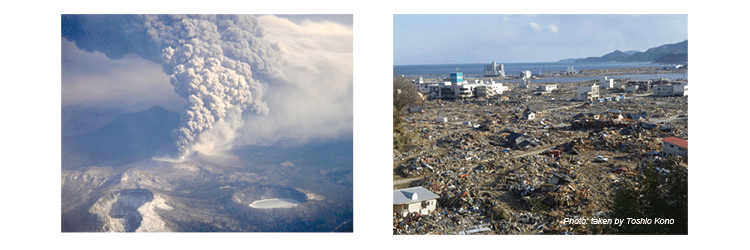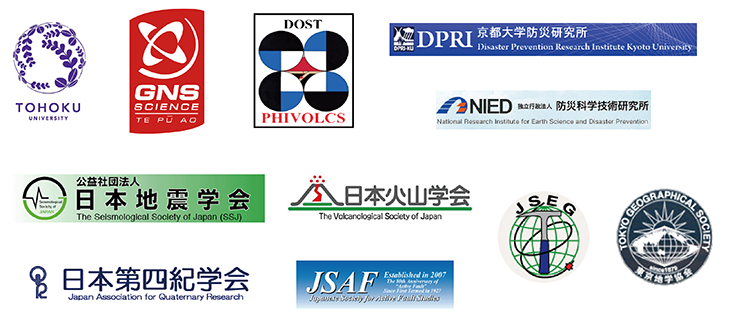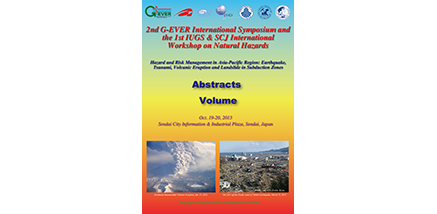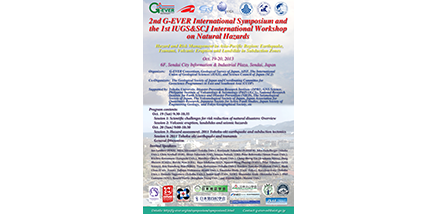




- Date:
- Oct. 19 (Sat) and Oct. 20 (Sun), 2013
- Venue:
- 6F, Sendai City Information & Industrial Plaza, Sendai, Tohoku, Japan
- Organizers:
- G-EVER Consortium
- Geological Survey of Japan, National Institute of Advanced Industrial Science and Technology (AIST)
- The International Union of Geological Sciences (IUGS)
- Science Council of Japan (SCJ)
- Co-Organizers:
- The Geological Society of Japan
- Coordinating Committee for Geoscience Programmes in East and Southeast Asia (CCOP)
- Supported by:
- Tohoku University
- Disaster Prevention Research Institute (DPRI), Kyoto University
- National Research Institute for Earth Science and Disaster Prevention (NIED)
- GNS Science
- Philippine Institute of Volcanology & Seismology (PHIVOLCS)
- The Seismological Society of Japan
- The Volcanological Society of Japan
- Japan Association for Quaternary Research
- Japanese Society for Active Fault Studies
- Japan Society of Engineering Geology
- Tokyo Geographical Society

- Background:
- Asia-Pacific Region is an area with high risk of catastrophic natural disasters such as earthquakes, tsunami and volcanic eruptions. In today's highly globalized economy, when a disaster occurs it can create unpredictable turmoil not just in the affected area but, all over the world. Countermeasures against these large-scale disasters are crucial for the sustainable development of the global economy to ensure human security. Now is the time to establish an effective international framework where we collaborate and develop a system to gather information on disaster mitigation in Asia-Pacific Region, including Japan.
- Purpose:
- After the 2011 Tohoku earthquake, more efforts for the prevention and reduction of the risks of natural disasters have been made all over the world. The G-EVER Consortium promotes activities in collaboration with international and national institutes and organizations as follows;
- Establishment of a framework for cooperation of research institutes and related organizations in the Asia-Pacific region working on seismic and volcanic disaster prevention
- Enhancement of exchange and sharing of various information on seismic and volcanic disaster prevention
- Building the international standard for the database, data exchange and disaster risk assessment
- The 2nd G-EVER International Symposium and the 1st IUGS & SCJ International Workshop on Natural Hazards aim to encourage extensive discussions on the present situation of natural disaster mitigation from earthquake, tsunami, volcanic eruption and landslide in the Asia and Pacific regions, including (1) important research works and priorities to make strong resilience to our society, (2) ideal hazard maps which are essential to the society and Asia-Pacific scale hazard assessment activities, and (3) importance of contributions to solid earth science. Intensive discussions on next-decade mitigation processes to reduce the risks of natural hazards are encouraged.
- Schedule:
- Oct. 19 (Sat) 9:00-9:30 Registration
- Oct. 19 (Sat) 9:30-18:35 Presentations
- Oct. 20 (Sun) 9:00-18:30 Presentations and General Discussion
- Oct. 19 (Sat) 9:30 – Oct. 20 (Sun) 18:30 Poster Session
- Abstracts Volume:

- 2nd G-EVER Symposium and the 1st IUGS&SCJ Workshop Abstract Volume (PDF, 12.5MB) (Updated Oct. 17, 2013)

- Program: (Slightly revised on Oct. 17)
- Oct. 19 (Sat)
- Opening addresses:
- Chair: Naoji Koizumi
- 9:30-9:45 Eikichi Tsukuda (Director General, GSJ, AIST, G-EVER Consortium President)
- 9:45-9:50 Roland Oberhaensli (IUGS President)
- 9:50-9:55 Ryo Matsumoto (SCJ-IUGS Japanese Branch)
- 9:55-10:00 Adichat Surinkum (Director, CCOP Technical Secretariat)
- Session 1: Scientific challenges for risk reduction of natural disasters: Overview
- Chair: Ryo Matsumoto, Yujiro Ogawa and Shinji Takarada
- 10:00-10:25 Catastrophic earthquakes and tsunami: Towards more effective risk reduction
- Ian Lambert (IUGS Secretary General) and Roland Oberhaensli (IUGS)
- 10:25-10:50 Response of the damaged scientists to the Tohoku earthquake-tsunami catastrophe
- Akira Ishiwatari (Tohoku Univ.)
- 10:50-11:15 Geosciences for post-2015 challenges of disaster risk reduction
- Kuniyoshi Takeuchi (ICHARM, PWRI)
- 11:15-11:35 [Coffee Break] (Group Photo)
- 11:35-12:00 Is satellite monitoring of remote volcanoes good enough for aviation safety?
- John Eichelberger (Alaska Univ., G-EVER Consortium Vice-President)
- 12:00-12:25 Scientific and social challenges of forecasting a VEI ≥7 eruption?
- Chris Newhall and Annie Winson (Earth Observatory of Singapore)
- 12:25 -12:50 Global earthquake and volcanic eruption risk management (G-EVER), next-generation volcanic hazard assessment system and Asia-Pacific region hazard mapping project
- Shinji Takarada, Joel Bandibas and G-EVER Promotion Team (Geological Survey of Japan, AIST)
- 12:50-14:30 [Lunch] & Poster Session Core Time
- SCJ-IUGS Japanese Branch Meeting
- Session 2: Volcanic eruption, landslides, seismic hazards, and hazard assessment
- Chair: James Goff, Yasuto Kuwahara and Akira Takada
- 14:30-14:55 Complexity of the Shinmoe-dake eruption in 2011
- Setsuya Nakada (ERI, Univ.of Tokyo)
- 14:55-15:20 From landslides to civil unrest: the implications of subduction zone earthquakes
- Peter Bobrowsky (Simon Fraser Univ.)
- 15:20-15:45 Submarine landslides and marine geohazards
- Kiichiro Kawamura (Yamaguchi University)
- 15:45-16:10 Landslides in tectonically active countries
- Masahiro Chigira and Toshitaka Kamai (Kyoto Univ.)
- 16:10-16:35 Landslide detection by broadband seismic network
- Cheng-Horng Lin (Academia Sinica)
- 16:35-16:55 [Coffee Break]
- 16:55-17:20 GEM-Faulted Earth: Towards a global active fault database
- Pilar Villamor (GEM-Faulted Earth team, GNS Science)
- 17:20-17:45 Proposals to revise ISC-GEM earthquake catalog
- Yuzo Ishikawa (Geological Survey of Japan, AIST)
- 17:45-18:10 Scenario-based tsunami hazard assessment for the coast of Vietnam from the Manila Trench source
- Nguyen Hong Phuong, Vu Ha Phuong and Pham The Truyen (VAST)
- 18:10-18:35 Toward a harmonized map of seismic hazard assessment (SHA) in the East Asia region
- Ken Xiansheng Hao and Hiroyuki Fujiwara (NIED)
- Oct. 20 (Sun)
- Session 3: Recent hazards, 2011 Tohoku-oki earthquake and subduction tectonics
- Chair: John Eichelberger, Ronald Harris and Kazuhisa Goto
- 9:25-9:50 Strong motion observation in April 20, 2013 Lushan, China, Earthquake and its damage implication
- Ruizhi Wen (China Earthquake Administration)
- 9:50-10:15 What occurred in the Japan trench region before and after the Tohoku-oki earthquake?: Seismological aspects
- Toru Matsuzawa (Tohoku Univ.)
- 10:15-10:40 Tsunami generation mechanism due to the 2011 Tohoku-oki earthquake and a new method for the real-time tsunami inundation prediction
- Yuichiro Tanioka and Aditya Gusman (Hokkaido Univ.)
- 10:40-11:00 [Coffee Break]
- 11:00-11:25 Subduction Zone Tectonics: Subduction accretion versus erosion and the implications for disastrous earthquakes
- Mark Cloos (Univ. Texas, Austin)
- 11:25-11:50 Crustal deformation of northeastern Japan clarified by geodetic observation over the past century
- Takuya Nishimura (Kyoto Univ.)
- 11:50-12:15 Strain buildup and release in the Northeast Japan orogen over geologic and geodetic time scales with implications for gigantic subduction earthquakes
- Yasutaka Ikeda(Univ. Tokyo)
- 12:15-13:30 [Lunch] & Poster Session Core Time
- Session 4: 2011 Tohoku-oki earthquake and tsunamis
- Chair: Pilar Villamor, Masahiro Chigira and Yuzo Ishikawa
- 13:30-13:55 The 2011 Tohoku-oki tsunami and paleotsunami deposits at the Pacific coast of Tohoku
- Kazuhisa Goto (Tohoku Univ.)
- 13:55-14:20 Sediment transport by the 2011 Tohoku-oki tsunami at Sendai Plain: implications from numerical simulation
- Daisuke Sugawara, Tomoyuki Takahashi and Fumihiko Imamura (Tohoku Univ.)
- 14:20-14:45 Tsunamis and tsunami deposits: Looking beyond the sand
- James Goff (Univ. NSW)
- 14:45-15:05 [Coffee Break]
- 15:05-15:30 Did earthquake science reduce causalities of the Mw 9.0 Tohoku-oki earthquake?
- Masataka Ando (Shizuoka University)
- 15:30-15:55 Implications of the 2011 Tohoku Earthquake for other subduction zones elsewhere
- Phil Cummins (ANU)
- 15:55-16:20 Who's next? History of tsunami disasters in Indonesia
- Ronald Harris, John Major and Yung-Chun Liu (Brigham Young University)
- 16:20-16:45 Geopolitics and earth's future: Natural disasters and related geoscientific research
- Yildirim Dilek (Miami University)
- 16:45-17:00 [Coffee Break]
- 17:00-18:25 General Discussion
- Chair: Chris Newhall, Yildirim Dilek, Yujiro Ogawa and Shinji Takarada
- 18:25-18:30 Hirokazu Kato (Emeritus Professor, Former Director General, GSJ, AIST)
- Closing Remarks
- Poster Session:
- P1. Quiescence in aftershock activity of the 2008 Iwate-Miyagi inland earthquake caused by the 2011 Tohoku-oki earthquake
- Yuhei Suzuki and Shinji Toda (Tohoku University)
- P2. Characteristic thickness distribution of the 2011 Tohoku-oki tsunami deposits in a narrow valley at the southern end of Sendai Plain
- Tomoya Abe (Nagoya University), Kazuhisa Goto (Tohoku University), Daisuke Sugawara (Tohoku University)
- P3. Tsunami deposits distribution in Sendai Plain evaluated by Sediment transport model
- Kohei Hashimoto (Tohoku University),Kazuhisa Goto (Tohoku University),Daisuke Sugawara (Tohoku University),Fumihiko Imamura (Tohoku University)
- P4. Geochemical characteristics of paleotsunami deposits
- Tetsuya Shinozaki, Shigehiro Fujino (University of Tsukuba) and Minoru Ikehara (Kochi University)
- P5. Distribution and age of the possible paleo-tsunami deposit at a coastal lowland, southeastern Kyushu
- Masaki Yamada, Shigehiro Fujino, Takashi Chiba (University of Tsukuba), Kazuhisa Goto (Tohoku Univ.) and James Goff (University of New South Wales)
- P6. Estimation of the sizes of paleotsunamis using tsunami boulders at Ishigaki Island, Japan
- Akifumi Hisamatsu, Kazuhisa Goto and Fumihiko Imamura (Tohoku University)
- P7. The combination of anisotropy of anhysteretic remanent magnetization (AARM) and grain size data provide information about the hydrodynamic conditions of the tsunami deposits
- Shusaku Kon, Norihiro Nakamura, Daisuke Sugawara, Kazuhisa Goto and Yasutaka Iijima (Tohoku University)
- P8. Deep structure of the seismic dangers regions in the Sea of Okhotsk
- Alexander Rodnikov (Russian Academy of Sciences)
- P9. Repeating earthquake activity along the Izu-Bonin trench
- Kota Hibino, Naoki Uchida (Tohoku University), Takeshi Matsushima (Kyushu University) and Toru Matsuzawa (Tohoku University)
- P10. Japan trench and Nankai trough: New scope of the two contrasting features of subduction zones and geo-hazardous aspect
- Yujiro Ogawa (Tsukuba University), Kiichiro Kawamura (Yamaguchi University), and Tomoyuki Sasaki (Ocean Engineering & Development Co. Ltd)
- P11. Sanriku-oki large slump deposits and feasibility studies for future scientific drilling accounting for submarine landslide mechanism
- Sumito Morita (GSJ, AIST), Shusaku Goto (GSJ, AIST), Yuichiro Miyata (Yamaguchi University), Yuki Nakamura (University of Tokyo), Yu Kitahara (Kochi University) and Yasuhiro Yamada (Kyoto University)
- P12. Structural characteristics of large-scale submarine landslides on a very gentle continental slope from 3D seismic data off Shimokita Peninsula, Northeast Japan
- Yuki Nakamura (University of Tokyo), Sumito Morita (GSJ, AIST), Juichiro Ashi (University of Tokyo)
- P13. The estimation of the low-velocity subducting crust of the Pacific slab beneath Hokkaido, northern Japan
- Takahiro Shiina, Junichi Nakajima, Genti Toyokuni, and Toru Matsuzawa (Tohoku University)
- P14. A study of earthquake location by artificial explosive data
- Chien-Hsin Chang, Peih-Lin Leu and Tzay-Chyn Shin (Department of Seismological Center, Central Weather Bureau, Taiwan)
- P15. Cooperative hydrological and geochemical research for earthquake forecasting in Taiwan between Disas.Prev.Res.Center, NCKU, Taiwan and Geological Survey of Japan, AIST
- Naoji Koizumi, Norio Matsumoto (GSJ, AIST), Wen-Chi Lai (National Cheng Kung University) and Mamoru Nakamura (University of the Ryukyu)
- P16. Experimental analysis on Rowe’s stress-dilatancy relation and frictional instability of fault gouges
- Momoko Hirata, Jun Muto, Hiroyuki Nagahama and Kenshiro Otsuki (Tohoku University)
- P17. Self-affinities Analysis of Fault-related Folding
- Kazuhei Kikuchi (Tohoku University), Kazutoshi Abiko (Yamagata Prefectural Government), Hiroyuki Nagahama and Jun Muto (Tohoku University)
- P18. Application of GIS Technology in heavy metal source analysis of river water in mining area
- Qingqing Lu, Noriyoshi Tsuchiya, Takahiro Watanabe, Ryo Yamada and Shinichi Yamasaki (Tohoku University)
- P19. Inhomogeneity of fractal property in rock minerals using 3D X-ray CT measurement
- Junko Yamaki, Jun Mutoa, Hiroyuki Nagahama, Osamu Sasaki, and Harumasa Kano (Tohoku University)
- P20. Seismic luminous phenomena and VHF electromagnetic emission originated from radon emanation
- Asuka Seki (Tohoku University), Izumi Tohbo (Mitsubishi Research Institute), Yasutaka Omori (National Institute of Radiological Science), Jun Muto and Hiroyuki Nagahama (Tohoku University)
- P21. Electromagnetic radiations from semiconductor minerals
- Mitsuyuki Ozawa, Jun Muto, Hiroyuki Nagahama, Toshiro Nagase (Tohoku University)
- P22. Sinusoidal model for the annual variation of atmospheric radon concentration in Japan
- Saki Nakamura, Koseki Hayashi, Yumi Yasuoka (Kobe Pharmaceutical University), Hiroyuki Nagahama, Jun Muto (Tohoku University), Yasutaka Omori (National Institute of Radiological Sciences), Tetsuo Ishikawa, Toshiyuki Suzuki, Yoshimi Homma (Fukushima Medical University), Hayato Ihara (Wakayama Medical University), Takahiro Mukai (Kobe Pharmaceutical University)
- P23. Hazard mitigation of a caldera-forming eruption: From past experience in Indonesia to modern society
- Akira Takada, Ryuta Furukawa (GSJ, AIST), Kiyoshi Toshida (CRIEPI), Supriyati Andreastuti and Nugraha Kartadinata (CVGHM)
- P24. Rainfall induced disasters in India with special reference to Uttarakhand calamity
- Ravi Kumar Umrao, Rajesh Singh and Trilok Nath Singh (Indian Institute of Technology)
- P25. Web Based Rapid Mapping of Disaster Areas using Satellite Images, Web Processing Service, Web Mapping Service, Frequency Based Change Detection Algorithm and J-iView
- Joel Bandibas and Shinji Takarada (Geological Survey of Japan, AIST)
- P26. Geoethical elements in risk communication
- Jose Luis González Garcia (Complejo de la Moncloa), Jesús Martínez-Frías (Geosciences Institute, CSIC-UCM) and Niichi Nishiwaki (Nara University)
- (Underline: presenter)
- Field Trip:
- Oct. 21 (Mon) Tsunami affected area by the 2011 off the Pacific coast Earthquake of Tohoku
- [Participants: 40 (max) ]
- Registration:
- From 9:00 Oct. 19, 2013 (Sat), 6F AER, Sendai City Information & Industrial Plaza, Sendai, Tohoku, Japan
- Admission:
- Free
- Instruction for Oral and Poster presentations:
- Oral presentation: Please prepare a PPT file (MS-Power Point 2007 or 2012 compatible) in a USB memory. The PPT file should be uploaded in the G-EVER's laptop computer (windows) before starting the author's session. (If the author prefer to use own laptop computer due to movie or other reasons, please let us know)
- Poster presentation: A board in 180cm (vertical) x 120cm (width) will be provided. Please prepare a poster to fit within this board. Display your poster until 9:30 on Oct. 19 and remove until 18:45 on Oct. 20. Push pins will be provided. Poster core times are 12:45-14:30 on Oct 19 and 12:15-13:30 on Oct. 20 during the lunch time (Please arrange your own lunch time). Free drink service (coffee and tea) will be provided at the poster presentation room.
- Publications:
- A report to the IUGS Episodes.
- A special publication volume on an international journal is planned.
- Hotel:
- Hotel room capacity in Sendai City is limited. We strongly encourage you to reserve your accommodation as soon as possible by applying online or other methods.
